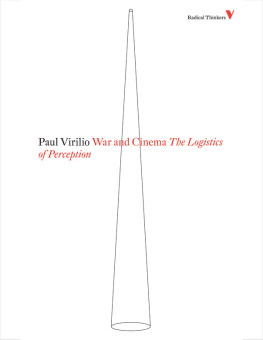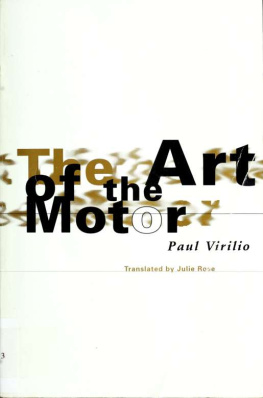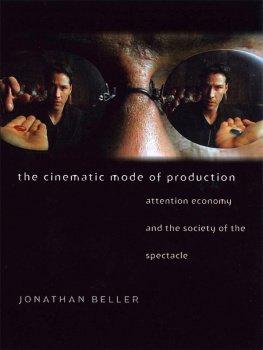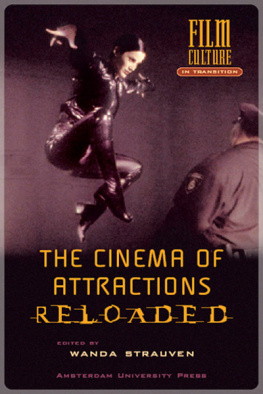Paul Virilio - War and Cinema: The Logistics of Perception
Here you can read online Paul Virilio - War and Cinema: The Logistics of Perception full text of the book (entire story) in english for free. Download pdf and epub, get meaning, cover and reviews about this ebook. publisher: Verso Books, genre: Science. Description of the work, (preface) as well as reviews are available. Best literature library LitArk.com created for fans of good reading and offers a wide selection of genres:
Romance novel
Science fiction
Adventure
Detective
Science
History
Home and family
Prose
Art
Politics
Computer
Non-fiction
Religion
Business
Children
Humor
Choose a favorite category and find really read worthwhile books. Enjoy immersion in the world of imagination, feel the emotions of the characters or learn something new for yourself, make an fascinating discovery.
- Book:War and Cinema: The Logistics of Perception
- Author:
- Publisher:Verso Books
- Genre:
- Rating:5 / 5
- Favourites:Add to favourites
- Your mark:
- 100
- 1
- 2
- 3
- 4
- 5
War and Cinema: The Logistics of Perception: summary, description and annotation
We offer to read an annotation, description, summary or preface (depends on what the author of the book "War and Cinema: The Logistics of Perception" wrote himself). If you haven't found the necessary information about the book — write in the comments, we will try to find it.
War and Cinema: The Logistics of Perception — read online for free the complete book (whole text) full work
Below is the text of the book, divided by pages. System saving the place of the last page read, allows you to conveniently read the book "War and Cinema: The Logistics of Perception" online for free, without having to search again every time where you left off. Put a bookmark, and you can go to the page where you finished reading at any time.
Font size:
Interval:
Bookmark:

WAR AND CINEMA: THE LOGISTICS OF PERCEPTION
Paul Virilio
First published by Cahiers du cinema/Editions de I'Etoile 1984
This edition first published by Verso 1989
Paul Virilio 1984
This translation, Verso 1989
All rights reserved
The moral rights of the author have been asserted
3579108642
Verso
UK: 6 Meard Street, London W1F 0EG
US: 20 Jay Street, Suite 1010, Brooklyn, NY 11201
www.versobooks.com
Verso is the imprint of New Left Books
ISBN-13: 978-1-84467-346-9
British Library Cataloguing in Publication Data
A catalogue record for this book is available from the British Library
Library of Congress Cataloging-in-Publication Data
A catalog record for this book is available from the Library of Congress
Typeset by Lapiz Digital Services, India
Printed in the US by Maple Vail
War is the art of embellishing death.
Japanese maxim
Acknowledgements are due to the following people and institutions for permission to reproduce photographs used as illustrations:
La Recherche, Paris 1983:1. Imperial War Museum, London: 2,3,7. Col Roy M. Stanley, Photo Intelligence, Sidgwick and Jackson, London 1982:5,6,12,16,26,27,28,29,30,31,32,33,34,35,36,37, 38,39,40,41. Nueva Forma, Madrid 1973: 14. L'Histoire en image, Cercle Europen du Livre: 17. E. Steichen, American Aerial Photography at the Front, US Air Service 1919:8. Signal 1941:18. After the Battle no. 41,1983:42,44. C. Bowyer, Pathfinders at War, Ian Allan, London 1977; 23,24,25. Mallory and Ottar, Architecture of Aggression, Architectural Press, London 1973: 19, 20, 22. David Shermer. The Great War, Octopus, London 1973: 4, 9. Cine MBXA, Cine Doc, Paris 1983: 11. R. Chambe, Histoire de laviation, Flammarion, Paris 1972:15. Cosmos Encyclopdie no. 2,1970: 47. Daidalos no. 3: 43. N. Frankland. Bomber Offensive, Purnells, London 1969: 21. Culture Technique no. 10, 1983:13, 45.
This essay investigates the systematic use of cinema techniques in the conflicts of the twentieth century. It is an approach that has never been adopted before, or hardly ever. Yet the strategic and tactical necessities of cartography were known long ago, and in the line from the emergence of military photography in the American Civil War to todays video surveillance of the battlefield, the intensive use of film sequences in aerial reconnaissance was already developing during the First World War. The general staffs had no other means of regularly updating their picture of reality, as artillery constantly turned the terrain upside down and removed the topographical references crucial to the organization of battle.
On board an aeroplane, the cameras peep-hole served as an indirect sighting device complementing those attached to the weapons of mass destruction. It thus prefigured a symptomatic shift in target-location and a growing derealization of military engagement. For in industrialized warfare, where the representation of events outstripped the presentation of facts, the image was starting to gain sway over the object, time over space. Soon a conflict of strategic and political interpretation would ensue, with radio and then radar completing the picture.
As it laid the ground for a veritable logistics of military perception, in which a supply of images would become the equivalent of an ammunition supply, the 1914-18 war compounded a new weapons system out of combat vehicle and camera a kind of advanced cinema dolly, one might say After the Second World War, it became possible to sketch out a strategy of global vision, thanks to spy-satellites, drones and other video-missiles, and above all to the appearance of a new type of headquarters. The central electronic-warfare administration such as the so-called 3Ci (control, command, communication, intelligence) in place in each major power can now attend in real time to the images and data of a planetary conflict. Thus, alongside the armys traditional film department responsible for directing propaganda to the civilian population, a military images department has sprung up to take charge of all tactical and strategic representations of warfare for the soldier, the tank or aircraft pilot, and above all the senior officer who engages combat forces.
Leaving aside the systematic use of simulators in preparations for land, sea and air missions, we should also mention the radical change in nuclear deterrence itself with the recent East-West disarmament initiatives. The gradual elimination of medium- and short-range theatre weapons, and their replacement by light, smart missiles such as the Midgetman, Stinger or Smart-Gun, are the harbingers of a final shift that will probably lead in turn to the disappearance of these latest weapons too. What will take their place will be directed-beam weapons using laser energy charged particles or electro-magnetic forces, which will function at the speed of light, after the fashion of the high-resolution cameras aboard military observation satellites.
When that stage is reached, probably at the end of the century, the deterrence strategy geared to nuclear weapons will give way to one based upon ubiquitous orbital vision of enemy territory: Rather like in a Western gun-duel, where firepower equilibrium is less important than reflex response, eyeshot will then finally get the better of gunshot. It will be an optical, or electro-optical, confrontation; its likely slogan, winning is keeping the target in constant sight. Winning here means the status quo of a new balance of forces, based not on explosives and delivery systems but on the instant power of sensors, interceptors and remote electronic detectors. As Merleau-Ponty once wrote; The problem of knowing who is the subject of the state and war will be of exactly the same kind as the problem of knowing who is the subject of perception. However, it is not human observers or military analysts themselves who will have this ubiquitous and surgically precise vision: rather, a sight machine aboard an intelligent satellite will automate perception of enemy territory in the finest detail, helping the missiles expert system to reach its decision at the speed of electronic circuitry
With this assumption of cybernetics into the heavens, we seem to have moved far away from military cinematography Yet the innovation of eyeless vision is directly descended from the history of the line of aim. The act of taking aim is a geometrification of looking, a way of technically aligning ocular perception along an imaginary axis that used to be known in French as the faith line (ligne de foi). Prefiguring the numerical optics of a computer that can recognize shapes, this line of aim anticipated the automation of perception hence the obligatory reference to faith, belief, to denote the ideal alignment of a look which, starting from the eye, passed through the peep-hole and the sights and on to the target object. Significantly the word faith is no longer used in this context in contemporary French: the ideal line appears thoroughly objective, and the semantic loss involves a new obliviousness to the element of interpretative subjectivity that is always in play in the act of looking.
If we tried to write a history of this line of force, of this perceptual faith, it would have to take account of quite a few vicissitudes, particularly since the invention of photography in the first half of the nineteenth century, followed by cinema, and then by videos, computer graphics and the active optics of the synthetic image.
Font size:
Interval:
Bookmark:
Similar books «War and Cinema: The Logistics of Perception»
Look at similar books to War and Cinema: The Logistics of Perception. We have selected literature similar in name and meaning in the hope of providing readers with more options to find new, interesting, not yet read works.
Discussion, reviews of the book War and Cinema: The Logistics of Perception and just readers' own opinions. Leave your comments, write what you think about the work, its meaning or the main characters. Specify what exactly you liked and what you didn't like, and why you think so.











